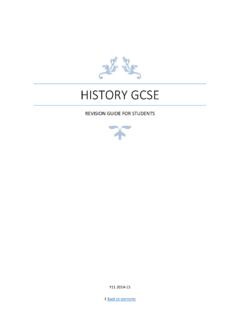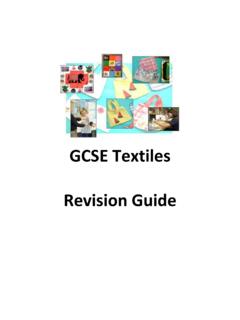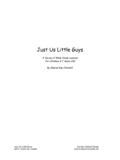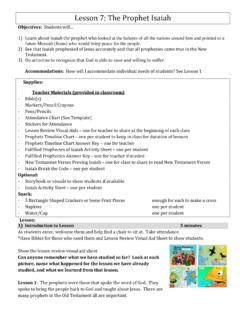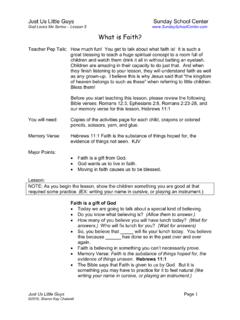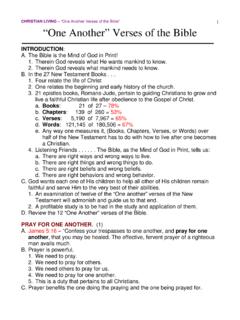Transcription of POETRY - The Bicester School
1 POWER AND CONFLICT POETRY Mr S Cox ABOUT: This booklet is designed to support you through the study of POETRY for your English Lessons. The work in this booklet can be used in a number of ways: a regular homework, revision aid, class resource or even just a catch up material if you have missed a topic. One thing this booklet is not however, is a quick fix. The exercises and information in this booklet are not made so you can just skip through or answer a few questions and then move on. If you do not read the instructions you will find that the work is not always correct and if you do not take the time to answer carefully in full sentences you will probably find that you don t practise your ability to answer questions as effectively as you would like.
2 The keys to success in English are: 1-Read lots, it honestly helps (there are studies into this and everything) 2-Start early, if you leave it all to the end you wont give it time to settle in your mind, the things you are probably best at are those you practise every day for years, English is the same. 3-Work hard, it is no use just being smart because if you expect to coast through on your intelligence you may be disappointed, and if not in your GCSE s then your A levels or Degree, trust me when I say it comes back to haunt you! Best of luck! By the way, you may see this logo and colourful boxes on many of the pages you work through.
3 This is your questions or thinking points that come with each topic, you should make sure you take the time to do these properly and label your work appropriately. If you work in a book or on paper then you should always make sure there is a clear topic title, page number and question number so it is easy to know where you are working from. The works included in this booklet have been heavily influenced by the work of other teachers and academics. The textual samples are from the Power and Conflict Cluster from the AQA Anthology and the creator of this booklet claims no credit for any of the textual extracts.
4 CONTENTS: 1 KEY TERMS 2 OZYMANDIUS 3 LONDON 4 PRELUDE (EXTRACT) 5 MY LAST DUCHESS 6 CHARGE OF THE LIGHT BRIGADE 7 EXPOSURE 8 STORM ON THE ISLAND 9 BAYONET CHARGE 10 REMAINS 11 POPPIES 12 WAR PHOTOGRAPHER 13 TISSUE 14 THE EMIGREE 15 CHECKING OUT ME HISTORY 16 KAMIKAZE 17 THEMES, STRUCTURE AND REVISION SUGGESTION: Although power points can be useful we have steered away here. Any of these resources of information can be copied over to a slide, but try and avoid repeating information for the sake of it, if they are watching a slide they are not watching you. It may be useful to include key video and images for help with context or readings but these are all additional elements which will fit your own teaching/learning style.
5 TEACHING AND LEARNING AKA: How to make the most of this booklet in class as a teacher and a stu-dent, some general teaching ideas and structures you could follow. There is more than one way to skin a cat, this booklet can be used to fit whatever you want, you can teach from or simply make it an online revision or cover tool, whatever, here are some ideas of how you can incorporate it into your lesson. LOOKING AT THE POEMS: Depending on the size of the poem and the lesson it would make sense that they can take more than one lesson to explore. A good way to structure the work over those lessons are: STARTERS: Initially mind maps or key images to explore what students already understand of context to do with the poem, another helpful tool is to look at certain lines in isolation (either as a group or in pairs) to see what students think this shows about the poem.
6 Later lessons can involve quick recaps and pop quizzes to remind students of key quotes, themes or technical features DEVELOPMENT: It is advised before showing or relying too heavily on the information in the book to get students to begin by looking at the poem and annotating themselves. Additional annotations can be worked through in groups or a class with direction, weaker groups could be given key terms to look for or lines to explore and thus guide their learning. It is then recommended (ideally on the next page in their book/folder) to summarise context, themes and structure (as we do in the booklet), to allow students to access revision notes in their own words.
7 REINFORCE: Call it a plenary if you will but to show something has sunk in I would recommend they evaluate/summarise the poem producing PEE paragraphs to support their findings. This could be through a given direction or simply asking explore 3 ways this poem shows power/conflict LOOKING AT THEMES/STRUCTURE Towards the back of the booklet, poems are linked by theme of structural styles to help students build on their understanding as well as compare and contrast, STARTERS: Initially they could be given give words/themes and be asked to pick the 3 poems they would link here and why, weaker groups could simply give 1-2.
8 Recapping poems is also useful and students can try and talk for 30-60 seconds on a poem, whoever can get closest without repeating ideas wins. DEVELOPMENT: It is advised to summarise how the poems (those given or which you decide) fit the themes, It would be useful to find 3/4 quotes for each poem based around those themes, this will allow students to quickly revise key poems and ideas. REINFORCE: Each theme/structural element has a sample task where students are advised to treat it like an exam. They should do a standard 4-6 paragraph essay with introduction and conclusion. At this point it is also useful to look at the exam mark scheme and really apply students knowledge to what they are being asked to perform.
9 ASSESSMENT OBJECTIVES If you are using AQA, your work will be assessed on these objectives, that means you should always aim to haave work which shows them off. They all get marks but not all the same amount, so AO1 and AO2 will get you in the region of 80% of your POETRY marks. AO1: Read, understand and respond to texts. Students should be able to: maintain a critical style and develop an informed personal response use textual references, including quotations, to support and illustrate interpretations. AO2: Analyse the language, form and structure used by a writer to create meanings and effects, using relevant subject terminology where appropriate.
10 AO3: Show understanding of the relationships between texts and the contexts in which they were written. AO4: Use a range of vocabulary and sentence structures for clarity, purpose and effect, with accurate spelling and punctuation MARK SCHEME A Sample of the mark scheme from AQA on the POETRY question highlights the following. Level 6 (Top Level) At the top of the level, a candidate s response is likely to be a critical, exploratory, well-structured comparison. It takes a conceptualised ap-proach to the full task supported by a range of judicious references. There will be a fine-grained and insightful analysis of language and form and structure supported by judicious use of subject terminology.



